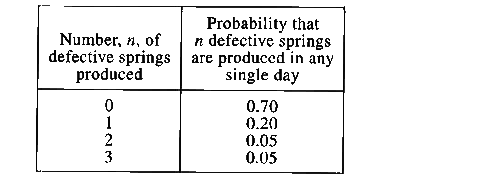Over the past 200 working days, the number of defective parts produced by a machine is given is given in the followig table.

Determine the probability that tomorrow's output will have
no defective part.
atleast one defective part.
nor more than 5 defective parts.
more than 13 defective parts.
Total numbers of working days, n(S)=200
i) Number of days in which no defective parts = n(E1)n(S)=50200=14=0.25
Hence, the probability that no defective part is 0.25.
ii) Number of days in which atleast one defective part, is
n(E2=32+22+18+12+12+10+10+8+6+6+2+2=150
∴ Probability that atleast one defective part =n(E2)n(S)=150200=34=0.75
Hence, the probability that all least one defective part is 0.75.
iii) Number of days in which not more than 5 defective parts,
n(E3)=50+32+22+12=146
∴ Probability that not more than 5 defective parts
n(E3)n(S)=146200=0.73
Hence, the probability that not more than 5 defective parts is 0.73.
iv) Number of days in which more than 13 defective parts
n(E4)=0
∴ Probability that more than 13 defective parts
=n(E4)n(S)==0200=0
Hence, the probability that more than 13 defective parts is 0.
Topper's Solved these Questions
- BOOK - NCERT EXEMPLAR ENGLISHCHAPTER - STATISTICS AND PROBABILITYEXERCISE - LONG ANSWER TYPE QUESTIONS12videos
STATISTICS AND PROBABILITY
- BOOK - NCERT EXEMPLAR ENGLISHCHAPTER - STATISTICS AND PROBABILITYEXERCISE - VERY SHORT ANSWER TYPES QUESTIONS10videos
STATISTICS AND PROBABILITY
- BOOK - NCERT EXEMPLAR ENGLISHCHAPTER - QUADRILATERALS EXERCISE - LONG ANSWER TYPE QUESTIONS18videos
QUADRILATERALS
- BOOK - NCERT EXEMPLAR ENGLISHCHAPTER - TRIANGLESEXERCISE - LONG ANSWER TYPE QUESTIONS21videos
TRIANGLES
Similar Questions
Over the past 200 working days, the number of defective parts produced by a machine is given in the following table :
∣∣ ∣ ∣∣Number of0 1 2 3 4 5 6 7 8 9 10 11 12 13defective partsDays50 32 22 18 12 12 10 10 10 8 6 6 2 2∣∣ ∣ ∣∣
Determine the probability that tomorrow's output will have :
(i) no defective part.
(ii) at least one defective part,(iii) more than 13 defective parts.View SolutionAn aircraft has 120 passsenger seats. The number of seats occupied during 100 flights is given in the following table.

Determine tha mean number of seats occupied over the flights.View Solution
Knowledge Check
- Question 1 - Select One
Machine A produces 500 springs a day. The number of defective springs produced by this machine each day is recorded for 60 days. Based on the distribution given below. What is the expected value of the number of defective springs produced by Machine A in any single day?
 A0.00B0.45C0.70D1.00
A0.00B0.45C0.70D1.00
Bulbs are packed in cartons each containing 40 bulbs, seven hundred cartons were examined for defective bulbs and the results are given in the following table.

One carton was selected at random. What is the probability that it has
i) no defective bulb?
ii) defective bulbs from 2-6?
iii) defective bulbs less than 4?View SolutionA cottage industry manufactures pedestal lamps and wooden shades.Both the products require machine time as well as craftsman time in the making. The number of hours required for producing 1unit of each and the corresponding profit is given in the following table : In a day, the factory has availability of not more than 42 hours of machine time and 24 hours of craftsman time, Assuming that all items manufactured manufacturer schedule his daily production in order to maximize profit ? Formulate it as an LPP and solve it graphically.
 View Solution
View SolutionA cottage industry manufactures pedestal lamps and wooden shades.Both the products require machine time as well as craftsman time in the making.The number of hours required for producing 1 unit of each and the corresponding profit is given in the following table:
In a day,the factory has availability of not more than 42 hours of machine time and 24 hours of craftsman time.
Assuming that all items manufactured are sold,how should the manufacturer schedule his daily production in order to maximise the profit?Formulate it as an LPP and solve it graphicallyView SolutionA factory has two machines A and B. Past records show that the machine A produced 60% of the items of output and machine B produced 40% of the items further 2% of the items produced by machine A were defective and 1% produced by machine B were defective. If an item is drawn at random, what is the probability that it is defective?
View SolutionOn one page of a telephone directory, there were 200 telephone numbers. The frequency distribution of their unit place digit (for example, in the number 25828573, the unit place digit is 3) is given in the table below: A number is chosen at random, find the probability that the digit at its unit’s place is: (i) 6 (ii) a non-zero multiple of 3 (iii) a non-zero even number (iv) an odd number.
View SolutionAn insurance company selected 2000 drivers at random (i.e., without any preference of one driver over another) in a particular city to find a relationship between age and accidents. The data obtained are given in the following table: Find the probabilities of the following events for a driver chosen at random from the city: (i) The driver being in the age group 18−29 years and having exactly 3 accidents in one year. (ii) The driver being in the age group of 30−50 year and having one or more accidents in a year. (iii) The number of drivers having no accidents in one year
View SolutionThree machinesE1, E2 and E3 in a certain factory producing electric bulbs, produce 50%, 25% and 25% respectively, of the total daily output of electric bulbs. It is known that 4% of the bulbs produced by each of machines E1 and E2 are defective and that 5% of those produced by machine E3are defective. If one bulb is picked up at random from a day’s production, calculate the probability that it is defective.
View Solution

